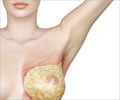
INDI's Kody Varahramyan and colleagues, Sudhir Shrestha, Mangilal Agarwal, Azadeh Hemati and Parvin Ghane explained that their system uses a planar microstrip antenna design on a flexible substrate that is optimised for operation in direct contact with the skin.
The system avoids the 20 percent microwave signal loss observed with other systems based on matched coupling medium.
Their tests with breast and tumor "phantoms" - model human body systems - showed that the received signal from a tumor is three times the strength from healthy tissue and is well defined relative to background noise level in the image.
The overall goal of the research is to develop a wearable, brassiere-like imaging system that uses non-ionizing radiation to detect cancerous breast tissue.
The researchers suggested that the system is cost effective and could detect breast cancer earlier than other systems, although they added that it would be a complementary system to mammography rather than a replacement for it. Nevertheless for early detection with minimal discomfort to the patients, such a system could become a useful adjunct for cancer detection.
Advertisement
Unfortunately, conventional mammography, which utilizes ionizing radiation, has a relatively high rate of false positives and false negatives as well as being uncomfortable. As such, the results for early breast tumors are often obscured by dense breast tissue and ambiguities present near the chest wall, which commonly leads to unnecessary biopsies.
Advertisement
The development has been described in detail in a forthcoming issue of the International Journal of Computer Aided Engineering and Technology.
Source-ANI














